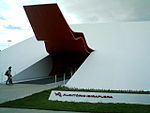Federal University of São Paulo

The Federal University of São Paulo (Portuguese: Universidade Federal de São Paulo, UNIFESP) is a university in the state of São Paulo, Brazil. Until 2005, UNIFESP was exclusively for Health Sciences, but after that year the university became multisubject due to Brazilian Federal Government's University Reform Program (REUNI). Now, the university has six campuses, the oldest in Vila Clementino, in São Paulo (Health) and four more in Guarulhos (Humanities area), Diadema (Science, Engineering and related), Santos (Health, Marine Sciences), São José dos Campos (Computational and Engineering fields) and Osasco (Business and related). New campus is planned in Santo Amaro, a district of (São Paulo). Despite the recent expansion, UNIFESP is considered one of the most prestigious universities in the country, attracting students from all over Brazil and neighboring countries.
Excerpt from the Wikipedia article Federal University of São Paulo (License: CC BY-SA 3.0, Authors, Images).Federal University of São Paulo
Rua Sena Madureira, São Paulo Moema
Geographical coordinates (GPS) Address External links Nearby Places Show on map
Geographical coordinates (GPS)
| Latitude | Longitude |
|---|---|
| N -23.5915 ° | E -46.6492 ° |
Address
UNIFESP
Rua Sena Madureira
04022-002 São Paulo, Moema
São Paulo, Brazil
Open on Google Maps










